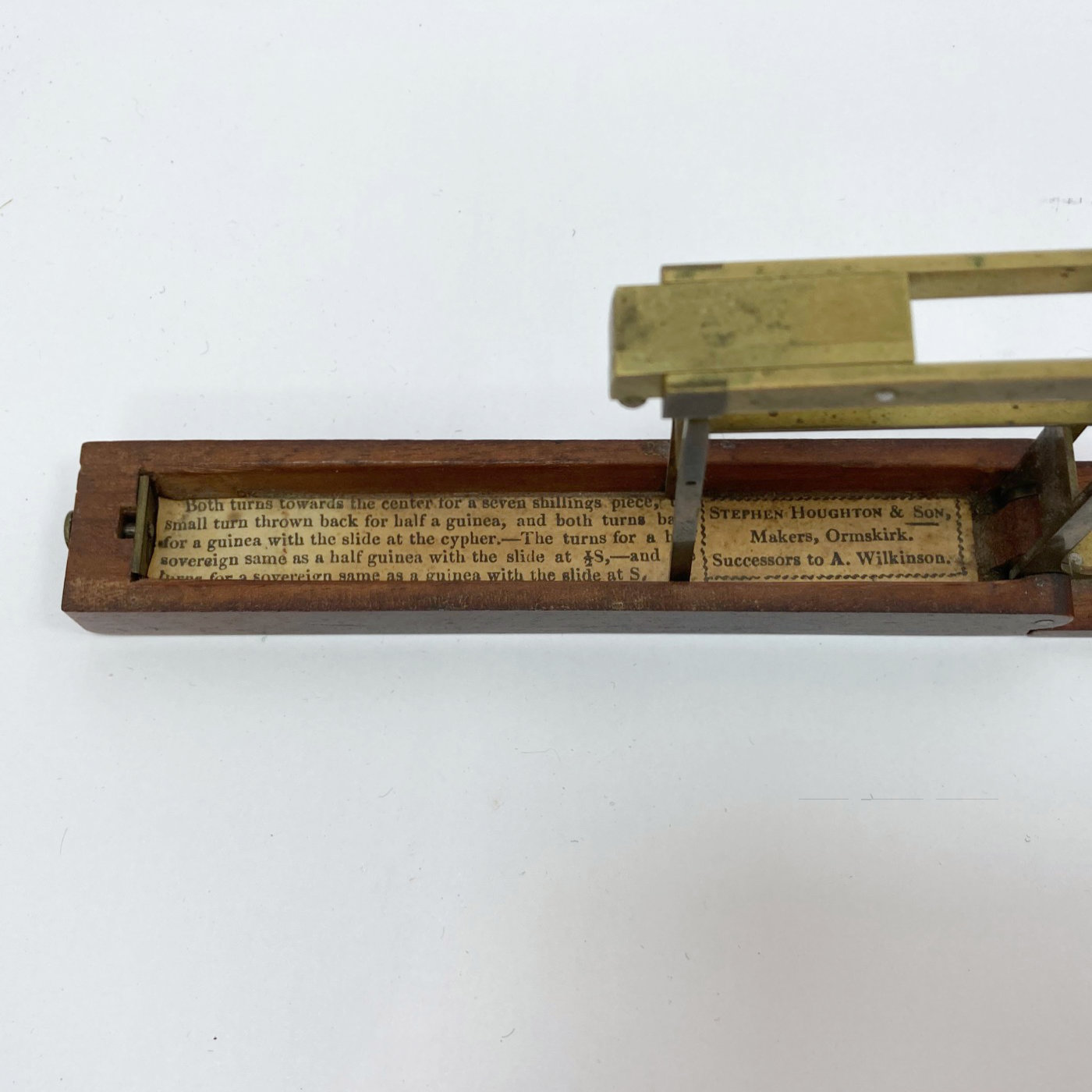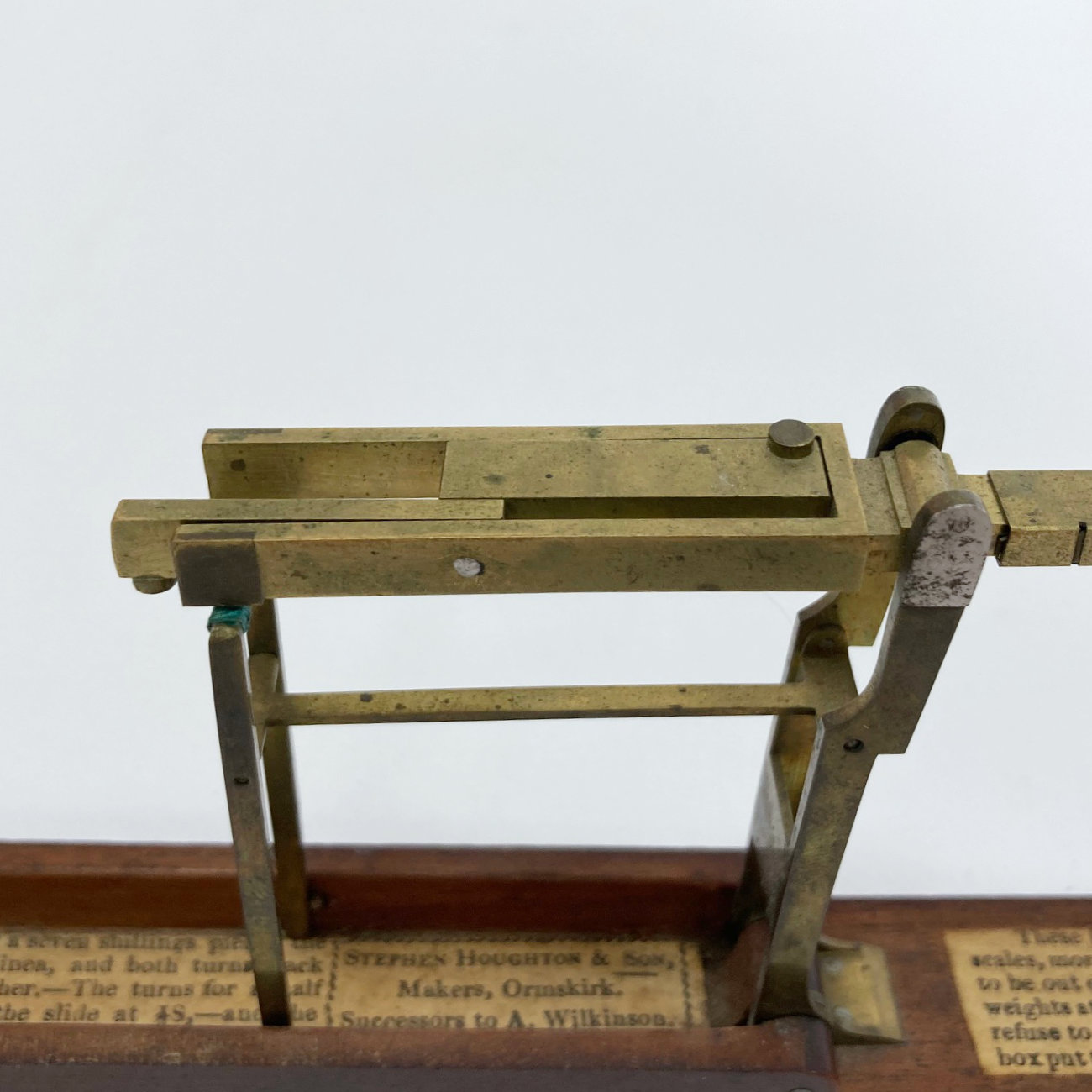Description
For sale a Regency Period double turn folding gold balance by Stephen Houghton & Son of Ormskirk (Successors to A. Wilkinson)
Comprised of a two-part narrow mahogany case with hinge at one side and push catch at the other. The lifting of the lid automatically raises a brass balance beam by means of two hinged supporting columns, and then a coin plate folded flat to the top is manually turned out for operation.
The beam end supports two additional hinged weights called “turns” which may be adjusted in accordance with the case instructions and the type of coinage. The balance arm also sports an engraved scale and slider which would be used to calculate subtle variations from the published standard weight. It is perhaps obvious to reference but the popularity of these ingenious scales was born out of the fact that gold was subject to both wear and tear and nefarious practices, meaning that the difference in the amount of gold contained in the same coin could be vastly different from one to the next. If you wished to ensure the real value of a transaction, a scale of some sort was an absolute necessity during the period.
Unlike most conventional scales, the method for determining the true weight of a coin was by placing the coin on the plate after making associated adjustments to the turns. If a coin was of full weight, then the beam would tilt to its fullest extent allowing the coin plate to rest and remain on lid of the case. If the coin was considered to be underweight, then the slide on the beam could be adjusted to determine the exact discrepancy.
This example retains both of its internal paper labels which read as follows:
“Stephen Houghton & Son, Makers, Ormskirk.
Successors to A. Wilkinson
Both turns towards the centre for a seven-shilling piece, small turn thrown back for half a guinea, and both turns back for a guinea with the slide at the cypher. The turns for a half sovereign same as a half guinea with the slide at 1/2S and the turns for a sovereign same as a guinea with the slide at S.
These balances are as accurate as the best of scales, more expeditious, portable, and not so liable to be out of order; they may be tried with sealed weights at any time for the satisfaction of those who refuse to take money by them. Before you shut the box put the slide to the cypher and turn up the scale.”
The company of Stephen Houghton & Son was formed in 1801 upon the death of Anthony Wilkinson, the original inventor of the folding balance. Houghton is listed as a tenant in one of Wilkinson’s Ormskirk properties from 1790 so whilst presenting himself as a watchmaker, it is likely that he had a prior working relationship with Wilkinson.
In early 1798, Wilkinson invented the double turn folding balance in order to incorporate weight measurements for the new seven-shilling piece (or third guinea) which was introduced in November of 1797, and it is this design that the Houghton business produced albeit with some later modifications to allow for the sovereign and half sovereign which followed after the Napoleonic wars in 1817.
Houghton & Son continued to advertising themselves as both watchmakers and gold balance makers until 1828 where after sheer demand probably led to a singular focus on scale making. It is documented that Houghton produced scales for resale to the likes of W&T Avery and De Grave as well as retailers across the country, which gives us some sense of the size of the business.
Stephen Houghton died in 1839 whereupon his son James inherited the business. It continued to prosper and later moved to Liverpool in 1853 where it traded until the late 1860’s.
Using coinage evidence, it is clear that with the inclusion of the sovereign on the paper label that this example was produced after 1817 and it is perhaps testament to the regard with which Wilkinson was held that the Houghton’s’ continued to use his name on their paper labels for that long. They seemingly continued to use this wording for as long as they were in production in Ormskirk but there are extant examples of a later style of label. Given that the guinea was replaced during the same period (1817). it would suggest a production date of the same timeframe presumably allowing the user to maintain guinea weight whilst the coinage transition was phased in.
Circa 1820




















